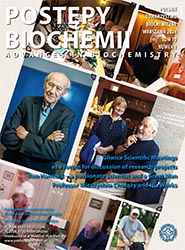Perspective Article: Space-time dynamics of genome replication studied with super-resolved microscopy
DOI:
https://doi.org/10.18388/pb.2021_523Abstract
Genome replication requires duplication of the complete set of DNA sequences together with nucleosomes and epigenetic signatures. Notwithstanding profound knowledge on mechanistic details of DNA replication, major problems of genome replication have remained unresolved. In this perspective article, we consider the accessibility of replication machines to all DNA sequences in due course, the maintenance of functionally important positional and structural features of chromatid domains during replication, and the rapid transition of CTs into prophase chromosomes with two chromatids. We illustrate this problem with EdU pulse-labeling (10 min) and chase experiments (80 min) performed with mouse myeloblast cells. Following light optical serial sectioning of nuclei with 3D structured illumination microscopy (SIM), seven DNA intensity classes were distinguished as proxies for increasing DNA compaction. In nuclei of cells fixed immediately after the pulse-label, we observed a relative under-representation of EdU-labeled DNA in low DNA density classes, representing the active nuclear compartment (ANC), and an over-representation in high density classes representing the inactive nuclear compartment (INC). Cells fixed after the chase revealed an even more pronounced shift to high DNA intensity classes. This finding contrasts with previous studies of the transcriptional topography demonstrating an under-representation of epigenetic signatures for active chromatin and RNAPII in high DNA intensity classes and their over-representation in low density classes. We discuss these findings in the light of current models viewing CDs either as structural chromatin frameworks or as phase-separated droplets, as well as methodological limitations that currently prevent an integration of this contrasting evidence for the spatial nuclear topography of replication and transcription into a common framework of the dynamic nuclear architecture.
Downloads
Published
License
Copyright (c) 2024 Marton Gelleri, Michael Sterr, Hilmar Strickfaden, Christoph Cremer, Thomas Cremer, Marion Cremer

This work is licensed under a Creative Commons Attribution 4.0 International License.
All journal contents are distributed under the Creative Commons Attribution-ShareAlike 4.0 International (CC BY-SA 4.0) license. Everybody may use the content following terms: Attribution — You must give appropriate credit, provide a link to the license, and indicate if changes were made, ShareAlike — If you remix, transform, or build upon the material, you must distribute your contributions under the same license as the original. There are no additional restrictions — You may not apply legal terms or technological measures that legally restrict others from doing anything the license permits.
Copyright for all published papers © stays with the authors.
Copyright for the journal: © Polish Biochemical Society.




